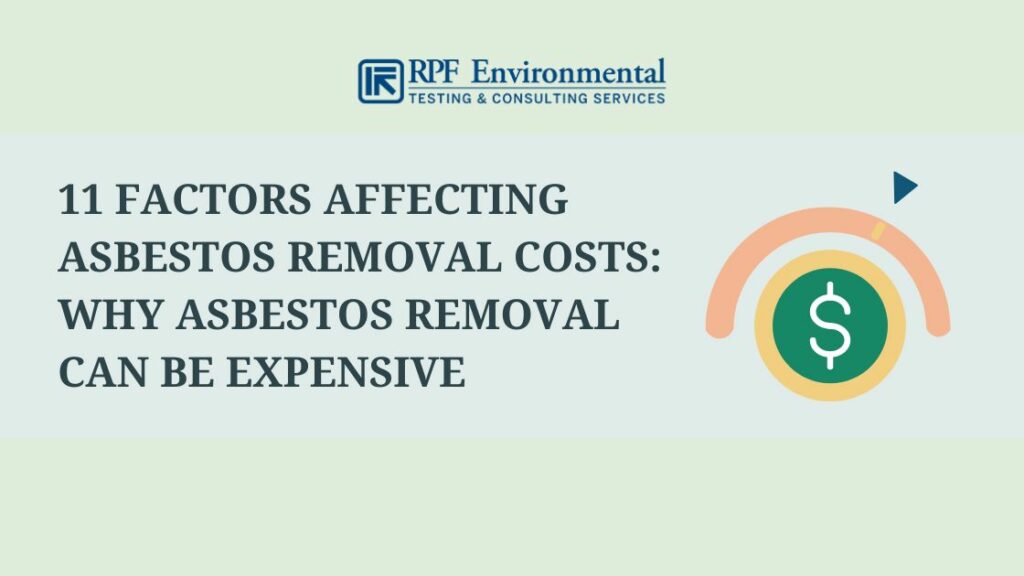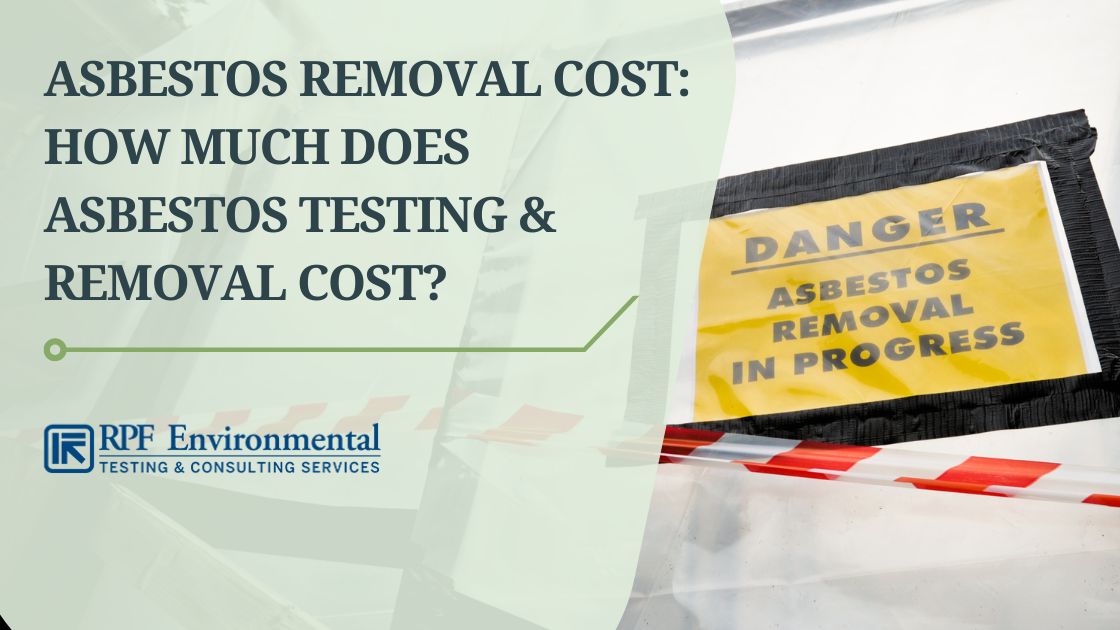If you live in or are buying an old house or commercial building and have discovered asbestos-containing materials, you should hire a certified asbestos testing and removal company to handle the job. Asbestos removal costs will vary widely depending on the complexity of the project including ease of access to the contaminated area and the extent of the contamination.
Also, the bulk of the cost goes to the preparation and setup process to keep the removal process as safe as possible and minimize the risk of exposure. Learn more about the average costs of removing asbestos and the factors affecting the price here.

RPF Environmental is a licensed asbestos survey and testing company that has been serving areas in Maine, Massachusetts, New Hampshire, and other areas in the U.S. for years. Contact us now for guidance in complete asbestos removal in your home or business at affordable rates!
Average Asbestos Testing & Removal Costs
Below are the average costs for testing and removing asbestos:
How Much Is an Asbestos Test?
Typical asbestos testing and inspection costs start at $1,000+ with an average of over $2,000 depending upon the amount of square feet that needs to be tested. It will depend on local asbestos regulations and state laws. Furthermore, you should let a certified inspector perform asbestos testing before and after removal to ensure that it is completely eliminated in your home/business.
How Much Is Asbestos Abatement?
The cost to remove asbestos in homes usually ranges between $1,000 to $3,000+ with an average of around $2,000+. It can also cost between $5 and $20 per square foot depending on the location of the asbestos material. For complete removal in average homes that include walls, ceilings, roof, floors, pipes, and attic, it can reach up to $15,000+. But for instances where removal is not needed, encapsulation is done which is cheaper and can cost around $400+.
11 Factors Affecting Asbestos Removal Costs: Why Asbestos Removal Can Be Expensive

If you are wondering why asbestos removal costs are often expensive, below are the factors that can affect them:
1. Location of the Asbestos
Locations that are easy to access will cost less while inaccessible areas are more dangerous to deal with and often involves demolition which makes them more expensive. Also, they will need extensive preparation and setup before the removal process is done.
Moreover, geographical location can also affect the cost due to varying permits needed, disposal fees, overall equipment prices, cost of services, and more. Expect removal in urban areas to be more expensive compared to rural areas. Local regulations will also affect how easy the removal process will be. For instance, some states consider specific types of non-friable asbestos to be nonhazardous and thus, cheaper to remove and dispose of.
2. Type of Asbestos
Asbestos removal contractors may charge depending on the type of asbestos. The most common ones are:
- Chrysotile: Known as white asbestos and is the most common type used in walls, ducts, ceilings, and floors. It is the cheapest to remove.
- Crocidolite: Known as blue asbestos and has thinner fibers that pose a higher health risk so it is more expensive to remove.
- Amosite: A rare brown asbestos that can’t be filtered by most HEPA vacuums. Thus, removal is more dangerous and expensive.
Moreover, asbestos abatement fees will depend on whether the asbestos is friable or non-friable. Friable asbestos can easily get damaged and become airborne and are most costly to remove.
3. Amount of Asbestos
The square footage of the asbestos to be removed and disposed of will matter, especially if sealing off large areas will be needed.
4. The Size of the Contaminated Area
Asbestos is not always found in the whole house. If it is only present in specific areas, removal will be easy. But when removing asbestos pipe insulation and wrapping, multiple rooms may need to be covered depending on where the pipe runs through. Each room needs to be sealed which will require more work and will increase removal costs.
5. Cost of Asbestos Testing
The cost of asbestos testing before and after the removal process will add to the costs that you need to consider. Also, it’s wise to have your home inspected by a specialist first if you suspect the presence of asbestos before you request removal. This way, you won’t need to pay for asbestos removal if you no contamination is found. Moreover, we recommend always hiring an asbestos inspector independent of any abatement company if your state doesn’t already require it.
6. Preparation and Setup Costs
Preparation and setup aim to prevent further exposure by ensuring that asbestos fibers won’t spread throughout the house/building during the removal process. It is the most crucial process that involves sealing off the contaminated area and covers 60%-70% of the total removal cost. Smaller areas like when removing asbestos tiles from a single room will cost less. On the other hand, asbestos removal on a whole floor requires more preparation and materials and will be more expensive. An example is when removing asbestos in pipes that run through multiple rooms.
7. Equipment to be Used
The type of equipment and materials that will be used will also have a huge impact on the cost. Aside from the materials that will be used for isolating the area and removal equipment, the workers also need to use protective equipment. Moreover, more extensive cleanups may need larger HEPA vacuums which are more expensive.
8. Labor
Expect an average of $200 per hour labor rate for each worker. Two workers are often enough to complete the removal in around eight hours. More extensive cleanups may need more workers and hours to complete which will increase the total cost.
9. Asbestos Encapsulation
Asbtestos-containing materials that are in good condition don’t need to be removed as they are less likely to pose a risk. However, they should be encapsulated or sealed to protect them from future damage and prevent the asbestos fibers from becoming airborne. Encapsulation usually costs 15-25% cheaper (around $2 to $6+ per square foot) than complete asbestos removal.
10. Asbestos Disposal
Asbestos is hazardous and EPA guidelines along with other state laws (which will determine the disposal fees) must be followed. Depending on your location, the cost of permits can range from $50 to $100 and disposal rates from $10 to $50 per cubic yard.
11. Repairs
After removing the asbestos-containing materials that can’t be encapsulated, they will also be repaired which will incur additional costs.
Asbestos Removal in Residential vs. Commercial Buildings
Below are the things you need to know about the removal of asbestos in residential and commercial buildings:
- Removal in residential homes is cheaper compared to commercial buildings where more area is covered and will require more extensive preparation and setup.
- Both residential and commercial buildings pose the same challenges when it comes to asbestos removal and disposal. The same techniques are also done. But with commercial buildings, asbestos abatement by a licensed professional is a must including multifamily homes in other states.
Also Read: Do Home Inspections Check for Asbestos?
Is it safe to remove asbestos on your own?
Although DIY removal can save you a lot, experts don’t recommend it. Dealing with asbestos is a dangerous job and you will need special equipment to complete the job properly and safely. Aside from that, some local laws may not allow DIY asbestos removal and you might face costly penalties and fines if you don’t hire a licensed professional.
Below are the benefits of hiring a professional asbestos abatement company:
- You save time and expenses on potential health issues caused by long-term asbestos exposure
- Guaranteed complete removal and safe cleanup of every area in your home
- Protection from potential violation due to improper removal and disposal
Is It Safe to Remove Asbestos on Your Own?
There are laws regulating encapsulation, disposal, and demolition requiring professional abatement to ensure safety and compliance. The majority of the asbestos abatement costs go to making sure that toxic exposure is minimized. DIY removal can result in life-threatening diseases like mesothelioma, lung cancer, and asbestosis.
Tips on How to Choose a Professional Asbestos Contractor
- Make sure that the company has the required permits and licenses and that they are well-versed in the local and state laws including OSHA and EPA standards.
- Ask if the workers are certified to conduct asbestos removal and how many will be working on the project.
- Ask about the duration of the process including the expected start and completion dates.
- Ask about their removal and cleanup processes including containment of the affected area and how they will collect, remove, and dispose of the contaminated materials.
- Ask whether they can do the repairs and replacements themselves or if you need to hire a third-party company to do the job.
Asbestos Removal Process: What to Expect During Asbestos Removal
Below is an overview of how asbestos abatement is done so you’ll know what to expect:
- Isolating the hazardous area
- Sealing off air ducts
- Disabling the HVAC system
- Dampening the fibers for easier removal
- Using a HEPA vacuum to trap toxic particles
- Disposal of asbestos-contaminated materials
- Final cleaning and inspection
- Post-cleanup
How Long Does Asbestos Removal Take?
Typical asbestos removal jobs only need two workers who can complete the job in one day. It’s the asbestos testing and inspection process before and after the project that takes longer.
How Do You Know if You Need Professional Asbestos Removal?
You should call a certified asbestos removal company if:
- You see signs of wear and tear along with water damage signs on suspected materials.
- You are planning to remodel or renovate your home, especially if you live in an old house.
Alternatives to Complete Asbestos Removal
Encapsulation is the only alternative to asbestos removal. The material is sealed off to prevent asbestos exposure caused by airborne particles once the material is damaged or disturbed. However, this can only be done if the professional asbestos testing company has confirmed that it is safe to do so.
FAQs
The workers should use a half-face, dual-cartridge respirator equipped with a NIOSH-rated filter (R-100, N-100, or P-100).
No, wearing a regular mask when doing DIY asbestos removal won’t be able to protect you. Even N95 masks can’t be used for asbestos because they can’t filter out the fibers.
Conclusion
Typical asbestos removal costs can vary widely from $2000 to over $15,000+ depending upon all of the factors listed above. The only way to get an exact estimate is by requesting a quote from a licensed asbestos abatement company. But before you proceed with hiring a removal company, better request asbestos testing and inspection from a third-party company first to confirm if you really need to do the asbestos removal.
RPF Environmental has licensed and trained asbestos testing and inspection experts who have been serving areas around the U.S. for years including Massachusetts, Maine, and New Hampshire. Book an appointment now!




